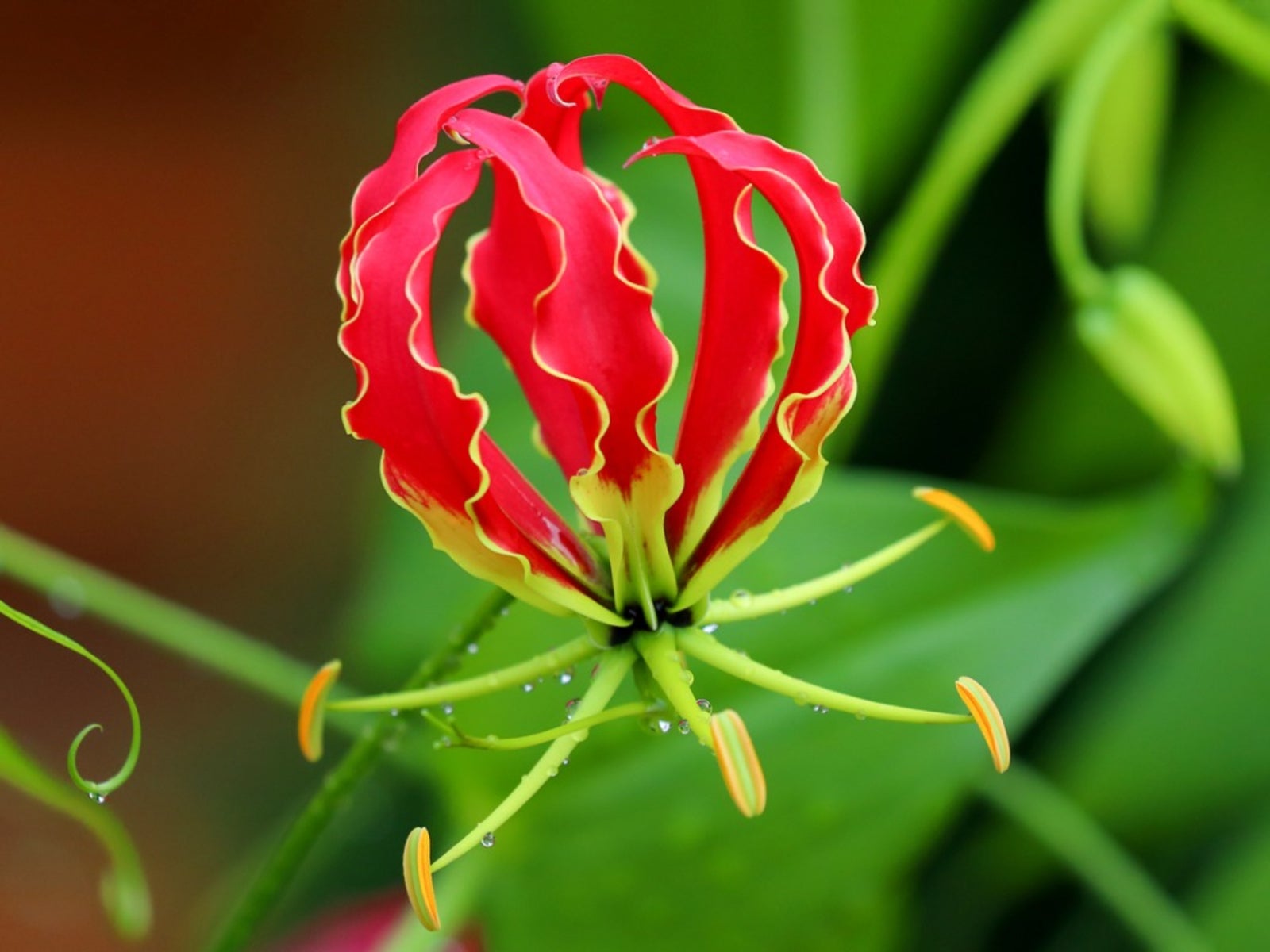Gloriosa Lily Planting: Tips For Growing A Climbing Lily Plant

Nothing quite compares to the beauty found in a Gloriosa lily (Gloriosa superba), and growing a climbing lily plant in the garden is an easy endeavor. Keep reading for tips on Gloriosa lily planting.
About Gloriosa Climbing Lilies
Gloriosa climbing lilies, also known as flame lilies and glory lilies, thrive in fertile, well-drained soil in full to partial sun. Hardy in USDA plant hardiness zones 10 and 11, they can be overwintered successfully in zone 9 with winter mulch. In cooler areas, climbing lilies can be grown successfully during the summer and lifted and stored for the winter. These exotic-looking lilies produce an abundance of yellow and red flowers with petals that curl backward to resemble a flash of brilliant flames. They can reach heights of 8 feet (2 m.) and require a trellis or wall to climb. Although climbing lilies do not produce tendrils, the specialized leaves of the Gloriosa climbing lily cling to the trellis or other plant material to pull the vine upward. Learning how to grow Gloriosa lilies is the first step to creating a wall of brilliant color that will last all summer.
Gloriosa Lily Planting
Select a location that receives six to eight hours of direct sunlight a day. In southern climates, a location that allows the vines to grow in full sun while the roots of the plant remain shaded is the best location for growing a Gloriosa climbing lily plant. Some protection from afternoon sun may be needed as well. Prepare the soil by tilling to a depth of 8 inches (20 cm.) and amending with generous amounts of organic matter such as peat moss, compost, or well-rotted manure. Organic matter improves both drainage and aeration and provides a slow-release fertilizer to your climbing lilies. Erect a 6 to 8 foot (around 2 m.) trellis for your Gloriosa climbing lilies prior to planting. Check that it is secure and will not topple under the weight of the growing climbing lilies. The ideal time for Gloriosa lily planting is in the spring after the soil has warmed and all danger of frost has passed. Plant the Gloriosa lily tubers approximately 3 to 4 inches (8-10 cm.) from the trellis. Dig a hole to the depth of 2 to 4 inches (5-10 cm.) and lay the tuber on its side in the hole. Space the tubers 6 to 8 inches (15-20 cm.) apart to allow room for the mature plants to grow. Cover the tubers and gently firm the soil down to remove air pockets and secure the tubers.
Gloriosa Climbing Lily Care
Water the newly planted tuber to saturate the soil to a depth of 2 to 3 inches (5-8 cm.) to give your Gloriosa climbing lily a good start. Keep the soil evenly moist until shoots appear in two to three weeks. Reduce water to once or twice a week or whenever the soil feels dry an inch (2.5 cm.) below the surface. Gloriosa climbing lilies typically require an inch (2.5 cm.) of rain a week and need supplemental watering during dry periods. Train the vines to climb the trellis by tying them to the trellis with soft plant ties, if necessary. Although climbing lilies cling to the trellis once established, they may need some help from you to get them started. Fertilize climbing lilies every two weeks with water-soluble fertilizer designed for flowering plants. This provides the nutrients needed to promote healthy blooming. Cut the vines back in the fall after they are killed by the frost. Tubers can be lifted and stored in moist peat moss in a cool, dark place for the winter and replanted in the spring.
Gardening tips, videos, info and more delivered right to your inbox!
Sign up for the Gardening Know How newsletter today and receive a free copy of our e-book "How to Grow Delicious Tomatoes".
-
 Looking For Plants To Give You The Soft And Fuzzies? Try These 5 Fuzzy Leaf Plant Options
Looking For Plants To Give You The Soft And Fuzzies? Try These 5 Fuzzy Leaf Plant OptionsLovers of texture, drama, silver foliage and tactile plants will adore these special sensory garden additions. These fuzzy leaf plant options will leave you all aglow
By Susan Albert
-
 Get Ready For A Summer Of Hummers! Grow These Full Sun Hummingbird Plants and Flowers
Get Ready For A Summer Of Hummers! Grow These Full Sun Hummingbird Plants and FlowersIf you’re lucky enough to enjoy a sunny backyard, make sure you are maxing out on your pollinator opportunities and grow these full sun hummingbird plants and flowers
By Tonya Barnett